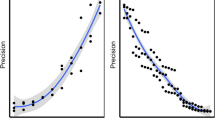Abstract
The cultivation of transgenic crops, such as maize, requires successful gene isolation in field environments. Five spatial statistical techniques are used to evaluate the use of a regional mesoscale observation network (Iowa Environmental Mesonet) as a means to drive field-scale pollen dispersion modeling. The Nearest Neighbor Index, Fractal Dimension, Morisita Index, Thiessen Polygons, and Coefficient of Representativity are computed showing the positive and negative impacts of sequential addition of observation networks into a mesonet framework (a collection of pre-existing networks). While it is shown that the arbitrary combination of disparate observing networks increases spatial resolution, this improvement is often at the expense of increased clustering due to co-location of observation sites near urban areas. Network composition in terms of density and degree of clustering was evaluated with a grid analysis using the Barnes scheme as a means to mitigate clustering and improve prediction accuracies when mesonet data are applied to modeling. This paper shows the importance of understanding and accounting for the spatial characteristics of an observational network before applying it to a modeling effort such as field scale pollen dispersion.




Similar content being viewed by others
References
Arritt RW, Clark CA, Riese JM, Westgate ME (2007) Lagrangian numerical simulations of canopy air flow effects on maize pollen dispersal. Field Crops Res (In review)
Aylor DE (2003) Rate of dehydration of corn (Zea mays L.) pollen in the air. J Exp Bot 54:2307–2312
Aylor DE, Schultes NP, Shields EJ (2003) An aerobiological framework for assessing cross-pollination in maize. Agric For Meteorol 119:111–129
Barnes SL (1964) A technique for maximizing details in numerical weather map analysis. J Appl Meteor 3:396–409
Brotzge JA, Richardson SJ (2003) Spatial and temporal correlation among Oklahoma Mesonet and OASIS surface-layer measurements. J Appl Meteor 42:5–19
Clark PJ, Evans FC (1954) Distance to nearest neighbor as a measure of spatial relationships in populations. Ecology 35:445–453
Di-Giovanni F, Kevan PG (1991) Factors affecting pollen dynamics and its importance to pollen contamination: a review. Can J For Res 21:1155–1170
Di-Giovanni F, Kevan PG, Nasr ME (1995) The variability in settling velocities of some pollen and spores. Grana 34:39–44
Doswell CA III, Lasher-Trapp S (1997) On measuring the degree of irregularity in an observation network. J Atmos Ocean Technol 14:120–132
Dubois G (2000) How representative are samples in a sampling network? J Geogr InfoDecision Anal 4:1–10
Fonseca AE, Lizaso JI, Westgate ME, Grass L, Dornbos Jr DL (2004) Simulating potential kernel production in maize hybrid seed fields. Crop Sci 44:1696–1709
Fonseca AE, Westgate ME (2005a) Relationship between desiccation and viability of maize pollen. Field Crops Res (in press) DOI 10. 1 016/j.fcr.2004. 12.001
Fonseca AE, Lizaso JI, Westgate ME, Grass L, Dornbos Jr DL (2005b) Risk index for outcrossing in hybrid seed com. Crop Sci (in review)
Goggi AS, Caragea P, Lopez-Sanchez H, Westgate M, Arritt R, Clark C (2006) Statistical analysis of outcrossing between adjacent maize grain production fields. Field Crops Res 99:147–157
Ireland DS, Wilson Jr DO, Westgate ME, Burris JS, Lauer MJ (2005) Managing reproductive iolation in hybrid seed com production. Crop Sci (in press)
Leroy M (1998) Meteorological measurements representativity, nearby obstacles influence. 10 Symp. On Meteorological Observations and Instrumentation, American Meteorological Society, 233–236
Lizaso Jr, Westgate ME, Batchelor WD, Fonseca A (2003) Predicting potential kernel set in maize from simple flowering characteristics. Crop Sci 43:892–903
Lovejoy S, Schertzer D, Ladoy P (1986) Fractal characterization of inhomogeneous geophysical measuring networks. Nature 319:43–44
Morisita M (1959) Measuring of the dispersion and analysis of distribution patterns. Mem Fac Sci Kyushu Univ Ser E Biol 2:215–235
Poehlman LM, Sleper DA (1995) Breeding field crops. Iowa State University Press, Ames, Iowa
Tessier Y, Lovejoy S, Schertzer D (1994) Multifractal analysis and simulation of the global meteorological network. J Appl Meteorol 33:1572–1586
Thiessen AH (1911) Precipitation average for large areas. Mon Weather Rev 39:1082–1084
Todey DP, Herzmann DE, Takle GS (2002) The Iowa Environmental Mesonet–combining networks into a single network. 6th Symposium on Integrated Observing Systems.Annual Meeting of the American Meteorological Society, 14–17 January, Orlando, FL
Watrud LS, Lee H, Fairbrother A, Burdick C, Reichman JR, Bollman M, Storm M, King G, Van de Water K (2004) Evidence for landscape-level, pollen-mediated gene flow from genetically modified creeping bentgrass with CP4 EPSPS as a marker. PNAS 101:14533–14538
Westgate ME, Lizaso J, Batchelor WD (2003) Quantitative relationships between pollen shed density and grain yield in maize. Crop Sci 43:934–942
Wolt JD, Shyy YY, Christensen PJ, Dorman KS, Misra M (2004) Quantitative exposure assessment for confinement of maize biogenic systems. Environ Biosafety Res 3:1–15
Acknowledgements
This research was supported by a grant from the United States Department of Agriculture’s Biological Risk Assessment Grants (BRAG) Program. The support of our project collaborators, M. Westgate and S. Goggi, and the helpful comments of anonymous reviewers are gratefully acknowledged.
Author information
Authors and Affiliations
Corresponding author
Rights and permissions
About this article
Cite this article
Herzmann, D.E., Wolt, J.D. & Arritt, R. Representativity of a mesoscale network for weather-related factors governing pollen dispersal. Int J Biometeorol 52, 617–624 (2008). https://doi.org/10.1007/s00484-008-0154-7
Received:
Revised:
Accepted:
Published:
Issue Date:
DOI: https://doi.org/10.1007/s00484-008-0154-7




